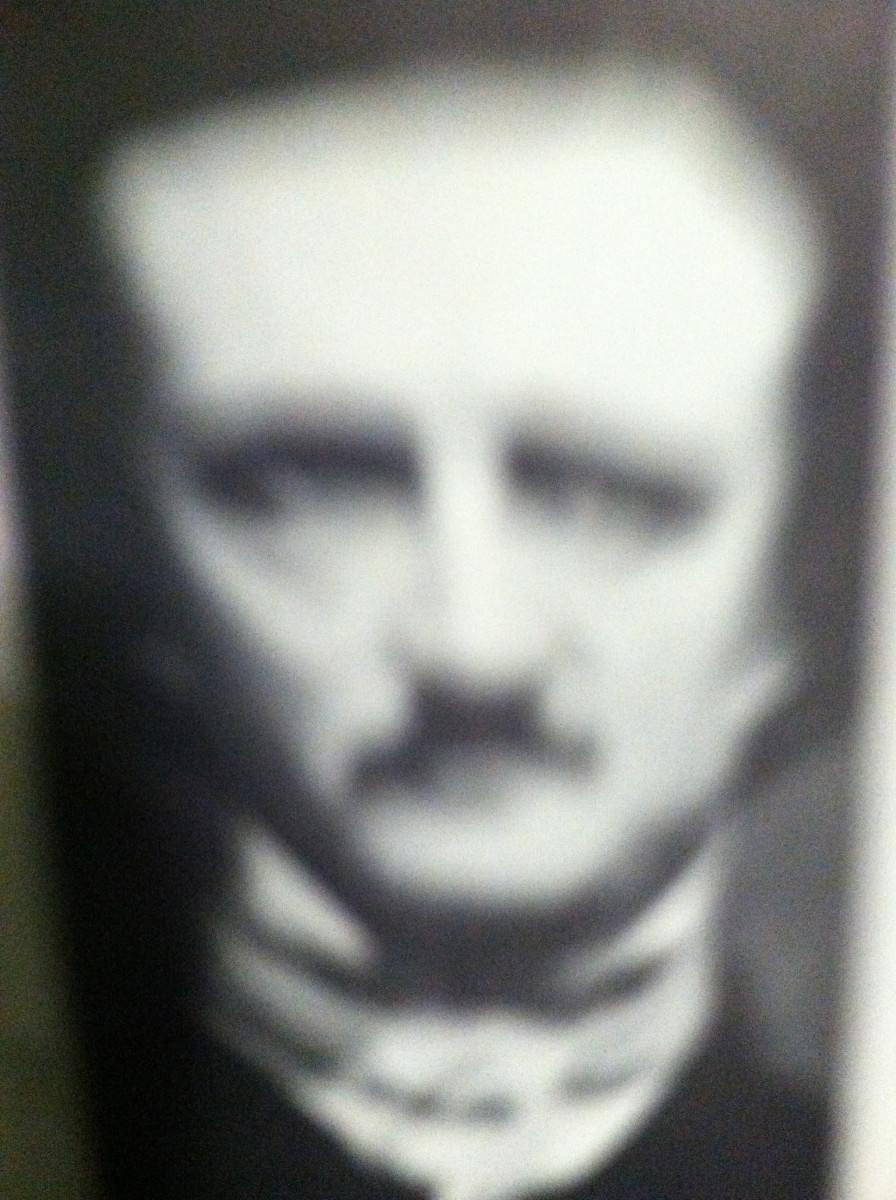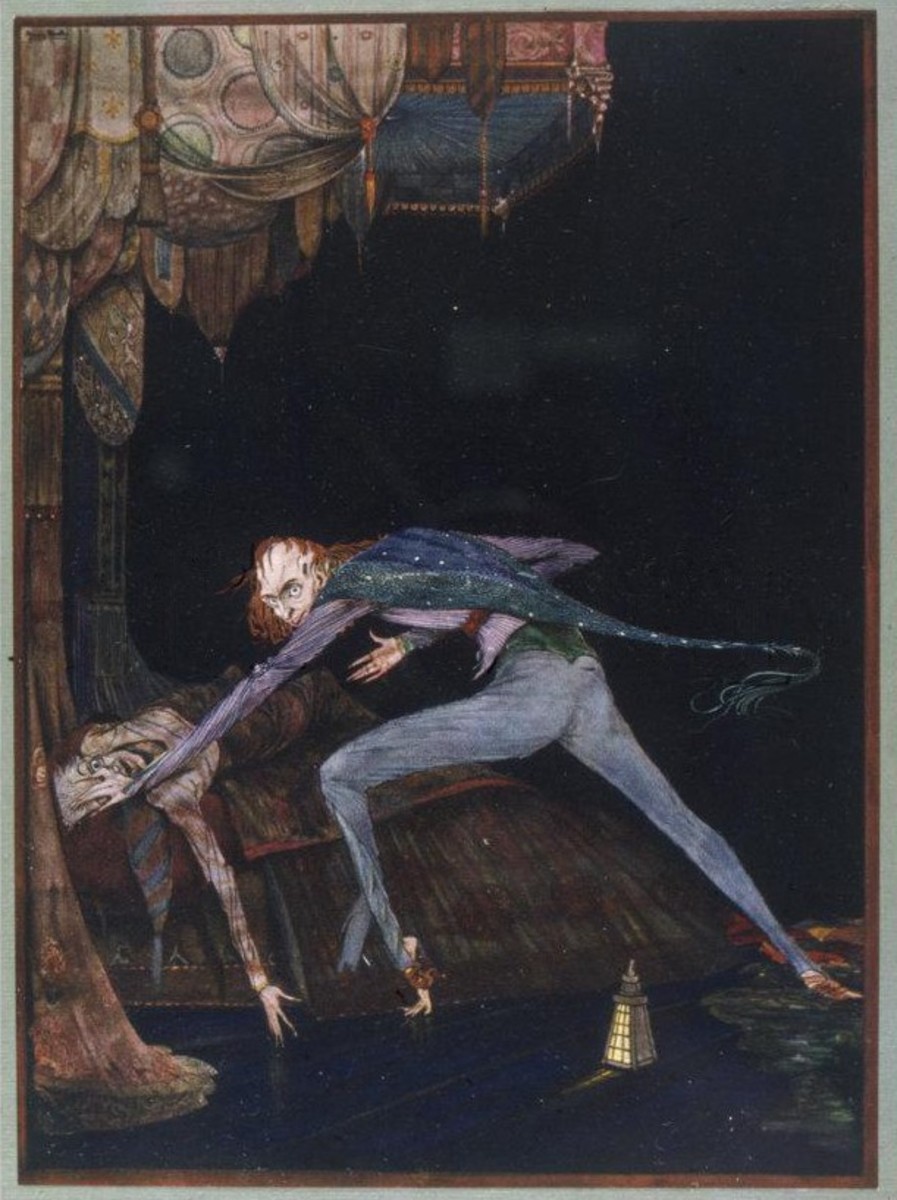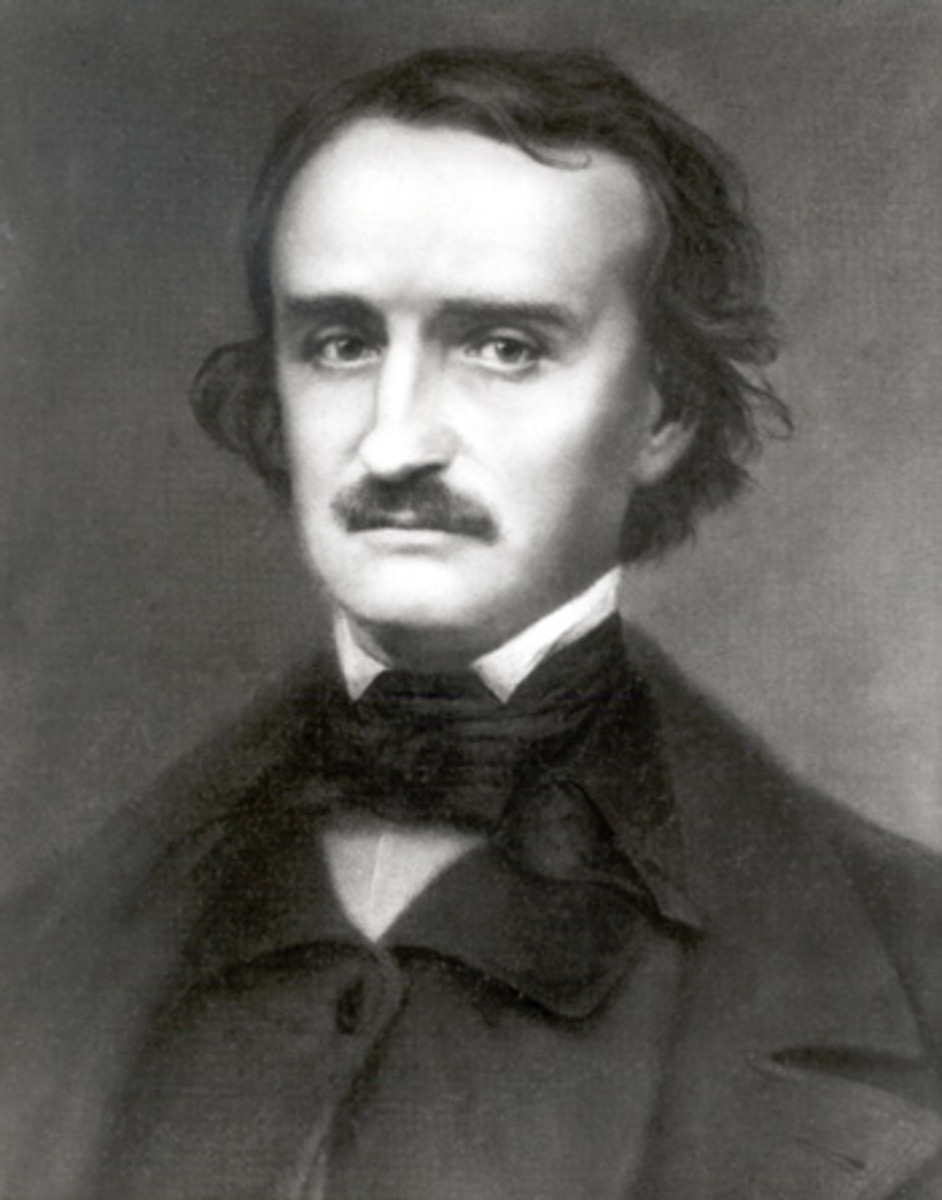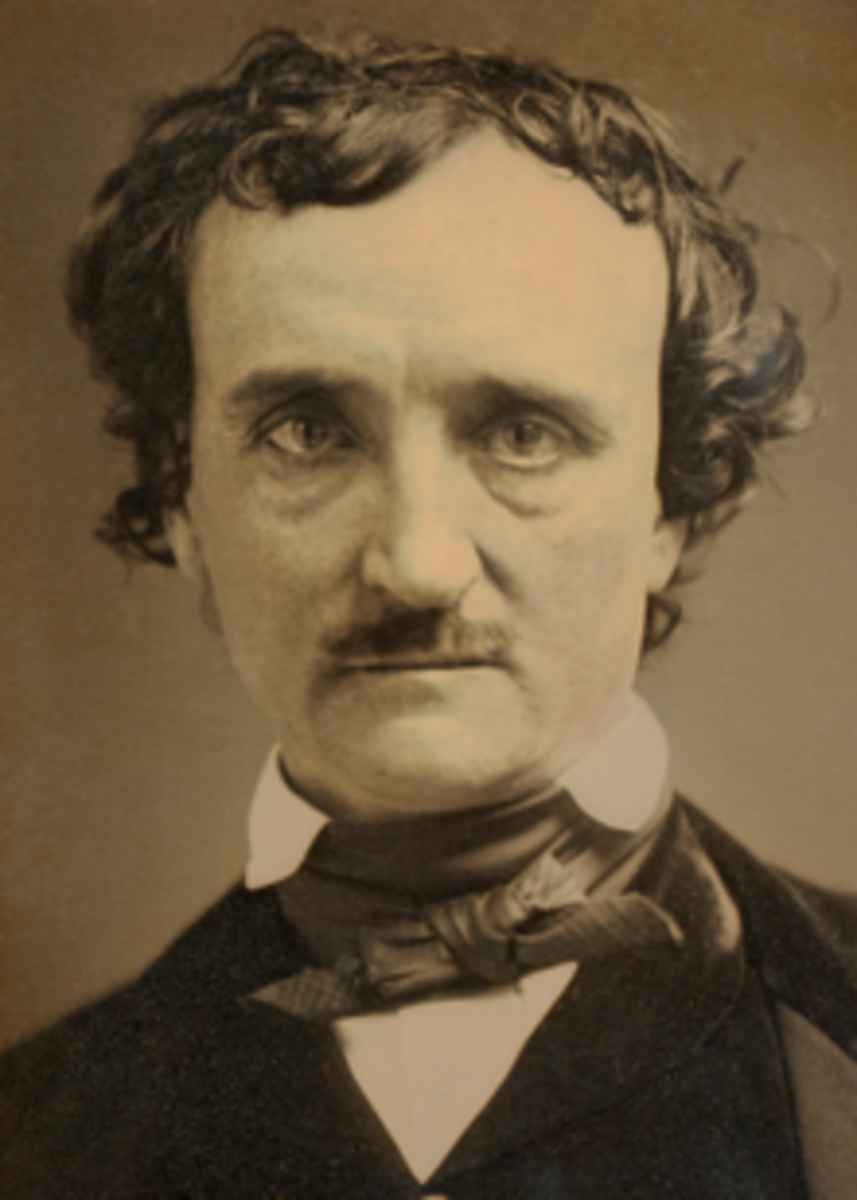- HubPages»
- Books, Literature, and Writing»
- Literature»
- American Literature
Edgar Allan Poe's "The Tell-Tale Heart"
I was never kinder to the old man than during the whole week before I killed him.
— Edgar Allan Poe
Summary
In Edgar Allan Poe's, "The Tell-Tale Heart" the narrator begins the story by convincing the reader that he is not a madman and that his actions were justified; that is, his actions of killing an old man were just. He informs the reader that he will tell a story in which he will defend his mortality, sanity and prove that he is a sane individual: His motivation was neither passion nor desire nor was it gold or revenge for an insult. He never despised the man, it was simply his eye; a pale-blue, vulture-like eye with a film all over it. He tried to convince the reader that he is not a madman, and that he loved the old man dearly by informing the reader about his ingenious and wise plan: Every night he snuck into the old man's bedroom, quietly—oh, so quietly! As he entered the man's room, he carefully put a lantern in the old man's bedroom. So, would a madman be as so wise as this? He then undid the lantern and aimed it at the vulture-like eye of the old man. The narrator continued to do this for several nights, and every morning he would confidently inquire as to how well the old man slept through the night. But one night, after he moved his head into the room very gently, he chuckled while thinking of his plans of killing the man; the old man then began to shuffle, startled by the noise, but the narrator stood still—silent—for he knew that he could not be seen. And after some time passed the narrator continued to move slowly into the room; however, as he was moving, he decided to open the lantern, but his thumb slipped; the old man stood erect out of his bed, crying out into the dark room. The narrator stood still, and later on in the story, the old man began to convince himself that no one was there; but, as the man did so, his heart began to beat heavily and quickly out of fear. The narrator then thought that the rest of the town would hear his beating heart, so he acted quickly: The narrator jumped on the old man—screaming like a madman all the while—, pulled him to the floor, and enveloped him with the bed, until his heartbeat ceased. He then asked the reader if you think him mad and he proves he is a sane human being by chopping the old man up into little pieces and placing his dismembered body under the house's floorboards.
After some time had passed, the doorbell rang, and a group of police officers asked the narrator about the scream coming from the old man's house. He then lies to them and informs them that he screamed during an awful dream he had. He then bade them welcome and asked them to enter the house. The narrator then lead them to the room in which he killed the old man, and they sit around the room discussing what had happened that night; however, he then begins to hear a noise that grew louder and louder—frightening and annoying the narrator: it was the sound of the old man's heartbeat! He then believed that the police officers heard the noise but were making a mockery of him. The narrator then screamed, cursed, and threw his chair in the air; he ripped the floorboards from the ground, revealing the corpse of the old man to the police! So, do you think him to be mad?
A Bit About the Old Man...
The Old Man: In this short story, the old man is a very interesting character; however, we only get to see his personality in the point of view of the murderous narrator. Although we do not get to fully understand the narrator's personality, we only understand that he is obviously old—hence his name of being called the old man—and that he has a very large blue eye. From his looks, the reader can infer that he is a gentle, quiet, and possibly polite individual; however, the looks of a character are deceptive, so we cannot really fully understand the old man's personality.
Listen to the audiobook!

Is the Narrator Really Mad?
During the beginning of this short story, the narrator explains as to why he killed the old man. As he does so, he becomes fairly nervous and begins to claim that he is not insane. Rather than being insane, he believes that he has a disease, which makes his senses strong. In the short story, the narrator explains how, "what you mistake for madness is but an over-acuteness of the senses" (2). He is telling us that his madness is mistaken for a super heightened hearing that he possess, and, in particular, one of the senses that is most acute is his hearing. In the exposition of the short story, the narrator explains how, "[he] heard all things in the heaven and in the earth. [He] heard many things in hell" (85). By referring to hell and heaven, the narrator is implying that he is able to hear voices; that is, the voices of the dead. This is also ironic because he is trying to prove that he is a sane individual, but by saying he hears voices, it implies that he is an insane person. In addition, this also shows that he is not necessarily attached to reality, due to his sick mind and body. In addition, it is as if he believes that his hearing is an excuse for the monstrosities that he has committed, which shows that he is insane. Irony is also used to prove his insanity when he dismembered the body of the old man. In this part of the short story, the narrator explains how, "If still you think [him] mad, you will think no longer when [he] describes the wise precautions [he] took for the concealment of the body. The night waned, and [he] worked hastily, but in silence. First of all [he] dismembered the corpse. [He] cut off the head and the arms and the legs" (88). This passage from the short story is very ironic, due to the fact that one would think that a man who dismembers the body of another is actually insane, rather than sane; in other words, anyone that kills another person is obviously insane, but the narrator would have us think otherwise. He believes that dismembering and concealing the body is wise—and normal—even though it actually shows that this man is far from sanity; he is a malevolent and mad murderer. This passage, therefore, uses irony to indicate the opposite point as to what the narrator is trying to make.

Lanterns, Evil Eyes, and Time
The Evil Eye: In this short story, the narrator describes the old man's eye as being the eye of a vulture—an evil eye! Although the narrator is showing how insane he is by thinking that an eye is evil, the purpose of the evil eye is more symbolic. A vulture is a symbol for appending death. The reason for this is because a vulture is a watchful but dangerous bird, that in the wild will surround its prey waiting for it to die, so that it could feed on the dead prey. It is possible that the narrator feels as if he is a potential victim of the old man, being haunted by an evil and menacing eye that he hates. Nonetheless, even though the narrator may feel as if the eye of the old man is menacing and evil, overall, it emphasizes the fact that he is an insane human being that loathes a harmless eye.
The Watch: Throughout the short story, a watch is mentioned several times as the narrator plans his attempt to kill the old man. In particular, the watch is mentioned as the narrator moves very slowly in and out of the old man's bedroom; nevertheless, it severs a more significant and important purpose: it represents the journey to death; that is, the old man's death. The narrator took a very long time to make his decision to kill the old man, which is emphasized by the description of the watch. Each click of the watch in the short story essentially represents the idea that death is inevitable, and that all humans must face it. For example, during the rising action of the short story, the narrator states "a watch's minute hand moves more quickly than did mine" (4). The narrator is basically comparing himself to a clock, as he iswatching the old man die; he is saying that he has control over death and is able to determine as to whether the old man lives or if he dies.
The Lantern: During the point in the story in which the narrator was watching the old man sleep in his bedroom, he was using a lantern in order to see the old man, which allowed him to adjust the amount of light that would be illuminated in the room. Although the lantern my seem as a meaningless object in the short story, it actually serves a much more important purpose: it is the narrator's weapon against the old man and symbolizes a lack of the narrator's insight in the story. And it also acts as a support for his beliefs. Lanterns are obviously able to provide light when in the dark; however, the lantern in this particular story represents the narrator's narrow viewpoint in this story, essentially allowing him to see things as he seems, even if he does not see them as they are. When the narrator turns on the lantern, only a very thin streak of light is emitted onto the old man, which does not allow the reader to fully see what he looks like; we rather only see his "evil eye." As stated before, the evil eye of the old man is what motivated the narrator to kill the old man; therefore, the lantern essentially aids the narrator in his attempt to kill the old man. And it also reinforces or emphasizes the narrator's viewpoint on the old man.
Hey, why not buy the short story, so you can decided for yourself if the narrator is mad or sane.
A Peculiar Setting
Edgar Allan Poe is a master at creating a suspenseful, enjoyable, and captivating story. His use of character development and complex story plots makes for amazing stories that have captured the attention of readers of decades. However, one of the main components of Poe's work that makes it suspenseful and intriguing is its use of setting and theme to help support the uncanny plot of the story. In the "Tell-Tale Heart," the setting of the story helps drive the plot, and it also captures the reader's attention. But before we go any further, there are three basic components of a story's setting that you should know about: the physical setting (where and when the story takes place), the political setting (which character is in power, and who gives the power), and the psychological setting or atmosphere (emotions and feelings created by the stories plot). The three components of this short story are used to extreme effectiveness, as they allow the reader to feel emersed within the short story.
Physical Setting: Firstly, the story takes place in an urban area. The reason for this is because the narrator describes how the one neighbour would be able to hear the old man die, which shows that the surrounding area has a low population and is fairly close to one another, thereby indicating it takes place in an urban area. Moreover, the narrator and the old man seem to be living in a very dark and somewhat grim looking house; however, we only get to learn about the old man's bedroom: a very dark place, which is not necessarily described to the reader in the novel, leaving us to believe that it is mostly dark and has an uncanny atmosphere. The reason that this adds to the overall effectiveness of the portraying the narrator as a psychopathic murderer is because one would normally assume that a bedroom is a place of rest and peace. However, the narrator destroys the sense of safety in a bedroom by killing the old man and creating a dark and sinister mood of the short story.
Psychological Setting: Although the reader may know that the narrator and old man are living in a very dark and somewhat depressing house, the descriptions of the physical setting also tie into the psychological setting. The psychological setting, or mood, of the short story, is suspenseful. Throughout the short story, Poe uses detailed descriptions of the narrator's emotions and thoughts to create suspense for the reader; that is, the suspense of the story is driven by the narrator's plan to kill the old man, which he continued to talk about for a large amount of time during the exposition of the short story. In addition, the reader also gets a sense of a mood of paranoia and insanity. For example, near the end of the short story, we get to see the narrator become maniacal, as he presumably hears the beating heart of the dead, old man. The narrator believes that he is hearing the sound of the old man's heart beat, and begins to suspect that the officers questioning him will also begin to hear the beat: so, he begins to become hysterical. Through his actions, not only do we see his insane personality, but his actions also reinforce the overall mood of paranoia and suspense, which emphasizes his psychotic personality.
Political Setting: The atmosphere of the short story, "The Tell-Tale Heart" is suspenseful and uncanny, which allows the reader to understand that the narrator of the short story is insane, as it reinforces his dark and sinister personality. Nonetheless, the political setting of this short story also helps convey to the reader that the narrator is indeed psychotic. The political setting essentially describes which characters are in control or in power in the short story, and this is seen as part of the social environment of the character's society or separate. In this novel, the narrator is in power, as he plans and commits the murder of the old man without the man ever suspecting that he would kill him. By making the narrator be in power, Poe is emphasizing the fact that he is indeed insane. The reason for this is because it helps portray him as a maniac who wants to kill a helpless and defenseless old man. Therefore, the political setting also helps reinforce the idea of the narrator being mad.
Do you think that the narrator is mad?










